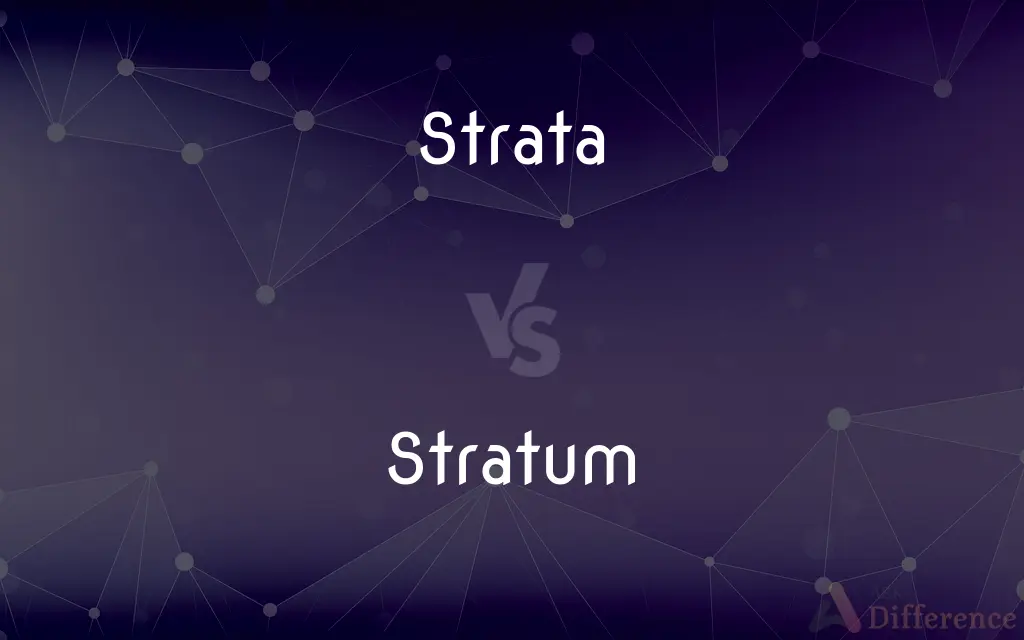Strata vs. Stratum — What's the Difference?
Edited by Tayyaba Rehman — By Fiza Rafique — Updated on April 3, 2024
Strata refer to multiple layers or levels in a series, often used in geology or social analysis, while a stratum is a single layer within such a series.

Difference Between Strata and Stratum
Table of Contents
ADVERTISEMENT
Key Differences
Strata encompass several layers or levels that are arranged one on top of another, typically used in the context of geological formations or hierarchical structures in society. These layers can represent different periods, materials, or social classes. Whereas a stratum represents just one of these layers, highlighting its individual characteristics, composition, or status within the overall structure.
Strata can be observed in various contexts, from the sedimentary layers of the Earth's crust to the socioeconomic levels within a population. Each layer within the strata holds its unique properties and significance, contributing to the overall understanding of the structure or system being analyzed. On the other hand, a stratum focuses on the specific attributes of a single layer, providing a detailed examination of its components, origins, or implications.
In geology, strata are critical for understanding the Earth’s history, as each layer may contain fossils or minerals that tell a story of past environments, climates, and biological evolution. A stratum, in contrast, allows scientists to concentrate on the details of one particular period or event, such as a volcanic eruption or the emergence of a new species, offering insights into the dynamics of Earth's past.
In sociology, strata reveal the complex organization of societies, differentiating groups by economic, social, or cultural criteria. This multilayered analysis helps in comprehending the social structure and mobility. Whereas examining a single stratum can shed light on the conditions, behaviors, and opportunities of a specific group, providing a focused perspective on social issues and inequalities.
While strata encompass the collective analysis of layers, providing a broad overview, a stratum offers a concentrated study, allowing for a deeper understanding of individual layers or levels. This distinction is crucial for researchers and analysts across various fields, enabling them to tailor their investigations according to the scope and depth required.
ADVERTISEMENT
Comparison Chart
Definition
Multiple layers or levels within a series.
A single layer within a series.
Usage Context
Geology, sociology, data analysis.
Geology, sociology, individual analysis.
Focus
Collective properties and the relationship between layers.
Specific characteristics of one layer.
Analysis
Broad, encompassing multiple layers.
Detailed, focused on a single layer.
Example in Geology
The sedimentary layers visible in a cliff face.
A specific limestone layer within the sedimentary sequence.
Compare with Definitions
Strata
Strata can also describe layers within statistical or computational models.
Data strata were used to ensure a representative sample in the study.
Stratum
A stratum is a single layer of rock or sediment in a larger sequence.
The limestone stratum contained fossils dating back millions of years.
Strata
Strata are layers of rock or soil with internally consistent characteristics.
The Grand Canyon reveals various strata, each telling a part of Earth's history.
Stratum
In sociology, a stratum is a specific social or economic level within a broader hierarchy.
The middle stratum often faces unique economic challenges.
Strata
In sociology, strata refer to the hierarchical levels of society based on class or status.
Social strata are evident in the distribution of wealth and resources.
Stratum
A stratum can refer to a layer within a statistical model or analysis.
Each stratum in the analysis represented a different age group.
Strata
Strata often imply a vertical or hierarchical arrangement.
Urban strata can be seen in the architectural layers of a city.
Stratum
In literature, a stratum may represent a single layer of meaning or thematic content.
This stratum of the story emphasizes the character's internal conflict.
Strata
In art and literature, strata can symbolize different levels of meaning or interpretation.
The novel's narrative strata offer multiple perspectives on the theme.
Stratum
Stratum can denote any distinct layer within a composite material.
The stratum of insulation was critical for the building's energy efficiency.
Strata
A plural of stratum.
Stratum
In geology and related fields, a stratum (plural: strata) is a layer of sedimentary rock or soil, or igneous rock that was formed at the Earth's surface, with internally consistent characteristics that distinguish it from other layers. The "stratum" is the fundamental unit in a stratigraphic column and forms the basis of the study of stratigraphy.
Stratum
A horizontal layer of material, especially one of several parallel layers arranged one on top of another.
Stratum
(Geology) A bed or layer of sedimentary rock that is visually distinguishable from adjacent beds or layers.
Stratum
Any of the regions of the atmosphere, such as the troposphere, that occur as layers.
Stratum
(Biology) A layer of tissue
The epithelial stratum.
Stratum
A level of society composed of people with similar social, cultural, or economic status.
Stratum
One of a number of layers, levels, or divisions in an organized system
A complex poem with many strata of meaning.
Stratum
One of several parallel horizontal layers of material arranged one on top of another.
Stratum
(geology) A layer of sedimentary rock having approximately the same composition throughout.
Stratum
Any of the regions of the atmosphere, such as the stratosphere, that occur as layers.
Stratum
(biology) A layer of tissue.
Stratum
A class of society composed of people with similar social, cultural, or economic status.
Stratum
(ecology) A layer of vegetation, usually of similar height.
Stratum
(computing) The level of accuracy of a computer's clock, relative to others on the network.
Stratum
A bed of earth or rock of one kind, formed by natural causes, and consisting usually of a series of layers, which form a rock as it lies between beds of other kinds. Also used figuratively.
Stratum
A bed or layer artificially made; a course.
Stratum
One of several parallel layers of material arranged one on top of another (such as a layer of tissue or cells in an organism)
Stratum
An abstract place usually conceived as having depth;
A good actor communicates on several levels
A simile has at least two layers of meaning
The mind functions on many strata simultaneously
Common Curiosities
Can strata and stratum be used interchangeably?
No, because strata is plural and refers to multiple layers, whereas stratum is singular and refers to a single layer.
How are strata used in geology?
In geology, strata are used to study the layers of rock and sediment to understand Earth’s history.
What is the primary difference between strata and stratum?
Strata refer to multiple layers, while a stratum is a single layer within such a series.
What does a stratum represent in sociology?
In sociology, a stratum represents a specific social or economic level within a broader societal hierarchy.
Can the term strata apply to fields outside of geology and sociology?
Yes, strata can also apply to layers or levels within statistical models, computational structures, and various other contexts.
How do scientists study a stratum?
Scientists study a stratum by analyzing its composition, age, and the presence of fossils or artifacts, among other characteristics.
Can the concept of strata be applied in art?
Yes, in art, strata can symbolize different levels of meaning or layers of visual elements within a piece.
What role do strata play in data analysis?
In data analysis, strata are used to ensure samples are representative by dividing data into layers based on specific characteristics.
How can strata impact environmental studies?
Strata can impact environmental studies by revealing changes in the environment and helping to predict future geological or ecological changes.
Why is it important to distinguish between different social strata?
Distinguishing between different social strata helps in understanding societal structures, inequalities, and dynamics.
How does the analysis of a single stratum differ from the analysis of multiple strata?
The analysis of a single stratum focuses on detailed characteristics of one layer, while analyzing multiple strata provides a broader view of relationships and changes over time.
How do strata affect archaeological studies?
Strata affect archaeological studies by helping to date artifacts and understand the context of human activity over time.
What kind of information can strata provide about Earth's past?
Strata can provide information about past climates, biological evolution, and significant geological events.
Is there a specific way to identify a stratum in a layered sequence?
A stratum is identified based on its unique characteristics, such as composition, color, and texture, within a layered sequence.
Why is it useful to examine both individual strata and the entire sequence of strata?
Examining both individual strata and the entire sequence provides a complete understanding of the composition, history, and dynamics of a geological or societal structure.
Share Your Discovery

Previous Comparison
Dedicated vs. Reliable
Next Comparison
Kool vs. CoolAuthor Spotlight
Written by
Fiza RafiqueFiza Rafique is a skilled content writer at AskDifference.com, where she meticulously refines and enhances written pieces. Drawing from her vast editorial expertise, Fiza ensures clarity, accuracy, and precision in every article. Passionate about language, she continually seeks to elevate the quality of content for readers worldwide.
Edited by
Tayyaba RehmanTayyaba Rehman is a distinguished writer, currently serving as a primary contributor to askdifference.com. As a researcher in semantics and etymology, Tayyaba's passion for the complexity of languages and their distinctions has found a perfect home on the platform. Tayyaba delves into the intricacies of language, distinguishing between commonly confused words and phrases, thereby providing clarity for readers worldwide.















































